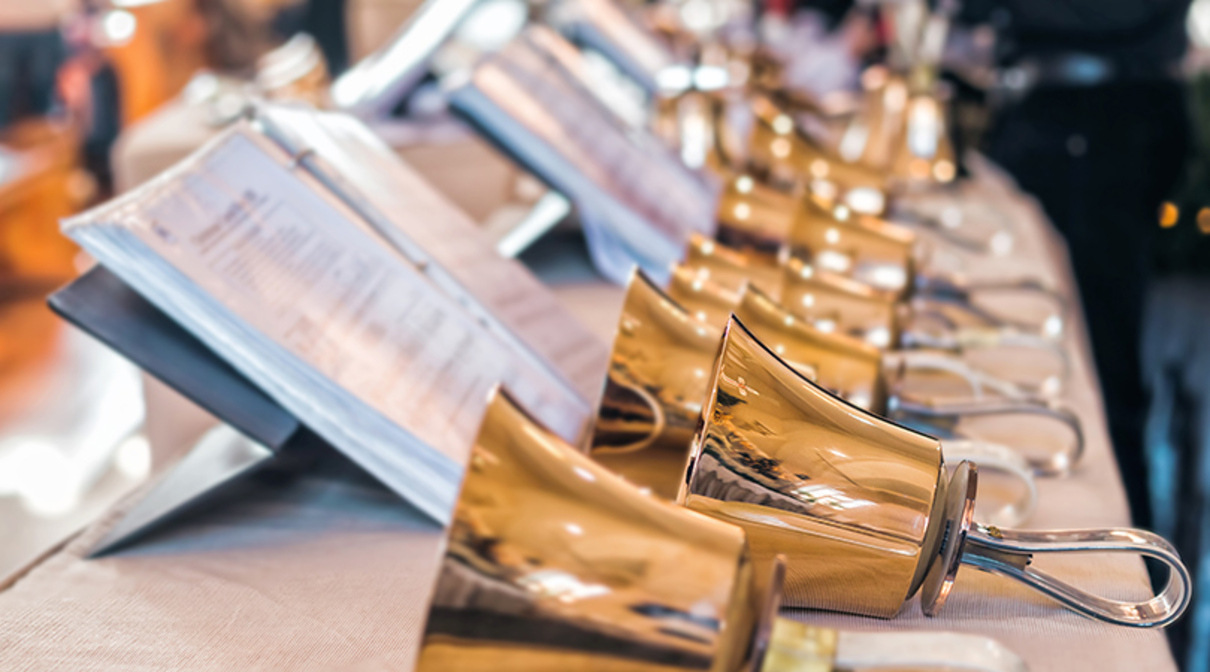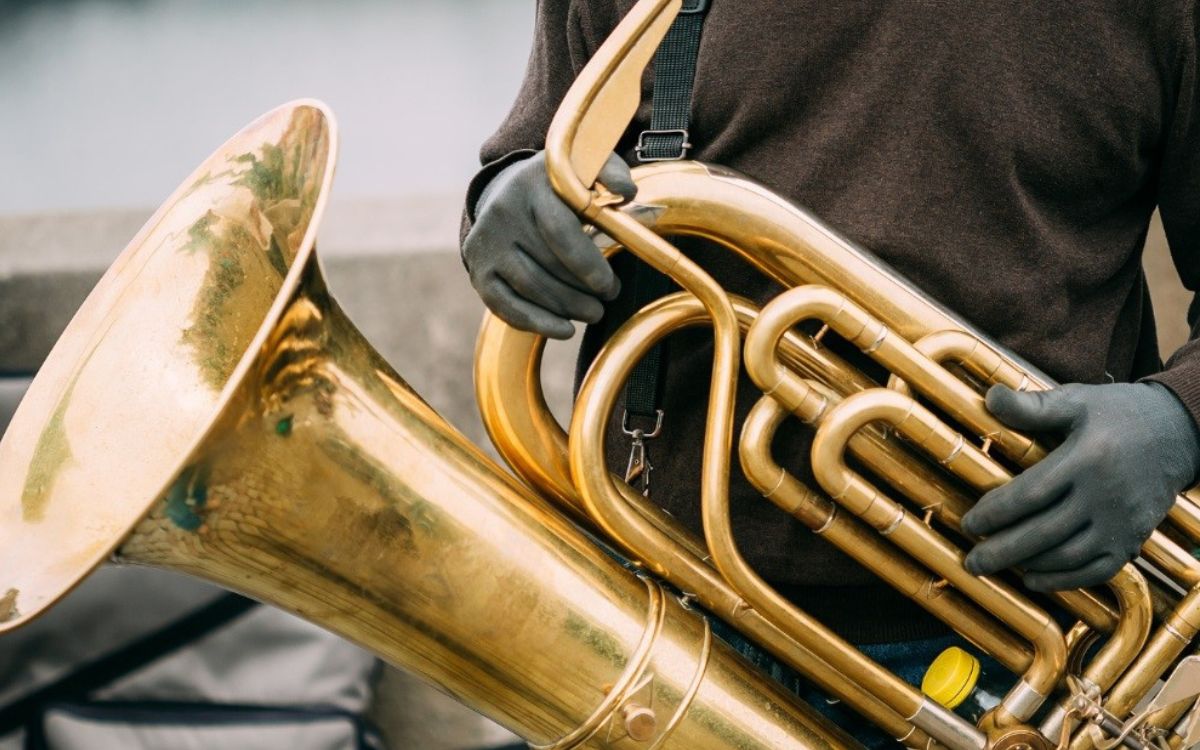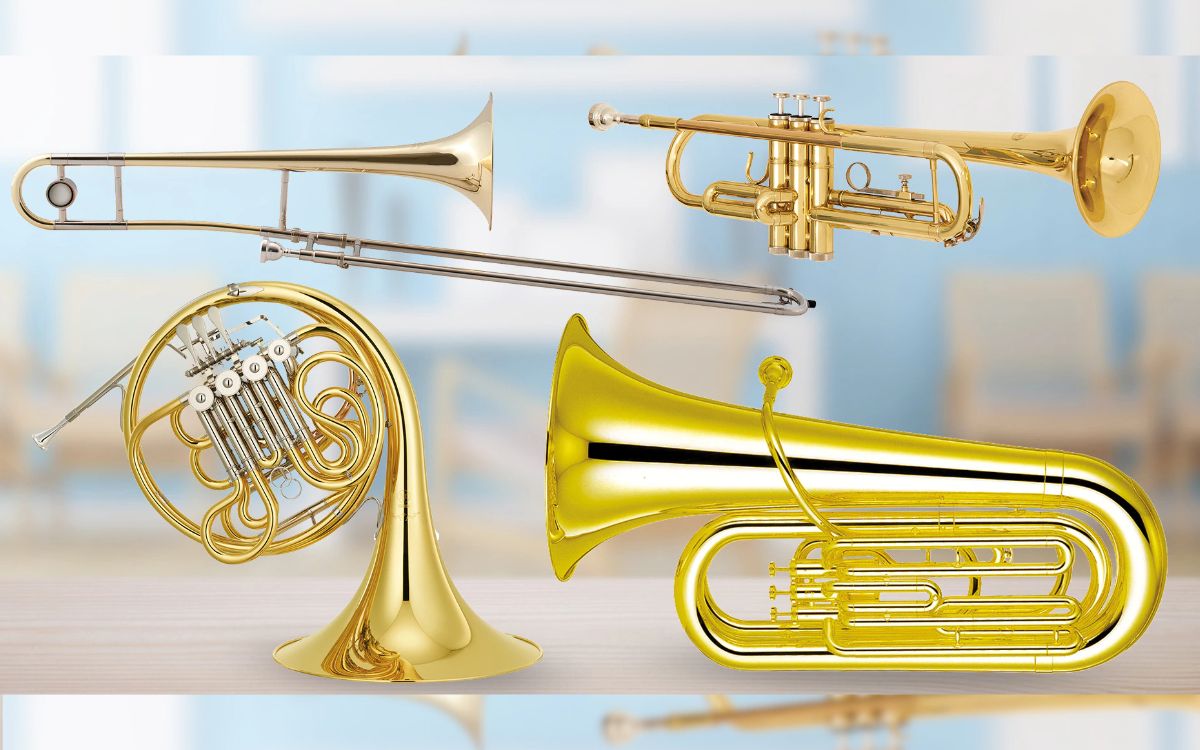Home>Instruments>Brass Instruments>How Does The Bell At The Brass Instruments Amplify Sound


Brass Instruments
How Does The Bell At The Brass Instruments Amplify Sound
Published: January 15, 2024
Discover how the bell on brass instruments amplifies sound and enhances musical performance. Explore the science behind this key feature of brass instruments.
(Many of the links in this article redirect to a specific reviewed product. Your purchase of these products through affiliate links helps to generate commission for AudioLover.com, at no extra cost. Learn more)
Table of Contents
Introduction
Welcome to the fascinating world of brass instruments! Whether you are a budding musician, an avid fan, or just curious about the mechanics of sound, this article will delve into the intriguing concept of how the bell of a brass instrument amplifies sound.
Brass instruments have been captivating audiences for centuries with their rich, vibrant tones and impressive range. From the regal sound of a trumpet to the mellow notes of a trombone, these instruments have found their place in various musical genres, from classical and jazz to rock and pop.
To understand how the bell of a brass instrument amplifies sound, it is essential to grasp the basics of sound waves and the unique features of brass instruments. Sound is a form of energy that travels in waves through a medium, such as air or water. These waves consist of compressions and rarefactions, which create variations in air pressure that are interpreted by our ears as sound.
Brass instruments, as the name suggests, are primarily made of brass and belong to the larger family of wind instruments. They include popular instruments like the trumpet, trombone, French horn, and tuba. The distinctive feature that sets brass instruments apart from others is the presence of a flared bell at one end.
The bell of a brass instrument plays a crucial role in shaping and amplifying the sound produced by the player. The design and construction of the bell, along with other factors, contribute to the unique timbre and projection of the instrument.
In the upcoming sections, we will explore the anatomy and function of the bell in greater detail. We will uncover the science behind how the bell amplifies sound and discuss the factors that influence sound amplification in brass instruments.
So, let’s embark on this melodic journey and unravel the mysteries of sound amplification in brass instruments!
The Nature of Sound Waves
To understand how the bell of a brass instrument amplifies sound, it is essential to grasp the nature of sound waves and how they propagate.
Sound waves are mechanical vibrations that travel through a medium, such as air or water. These vibrations are produced by a source, like a vibrating string or the lips of a brass instrument player, and they create changes in pressure in the surrounding medium.
Sound waves can be described by several key properties:
- Frequency: This refers to the number of cycles or vibrations that occur in a second and is measured in hertz (Hz). It determines the pitch of the sound, with higher frequencies corresponding to higher-pitched sounds and lower frequencies corresponding to lower-pitched sounds.
- Amplitude: This is the measure of the strength or intensity of a sound wave and is commonly associated with the volume or loudness of the sound produced. It is affected by the energy imparted to the medium by the sound source.
- Wavelength: This is the distance between two consecutive points of similar phase on the waveform. It is inversely proportional to the frequency, meaning that higher-frequency sounds have shorter wavelengths, while lower-frequency sounds have longer wavelengths.
When a sound wave encounters an object or an obstacle, such as the bell of a brass instrument, several interactions take place. These interactions can result in reflection, absorption, transmission, or a combination of these effects.
Reflection occurs when a sound wave bounces off a surface and returns towards its source. This phenomenon plays a significant role in sound amplification within brass instruments. The geometry and material properties of the bell determine how sound waves are reflected, redirected, and ultimately amplified.
Understanding the characteristics of sound waves helps us appreciate the importance of the bell in brass instruments and its role in amplifying the sound. In the next section, we will explore the anatomy and function of the bell in greater detail to uncover the secrets behind sound amplification in brass instruments.
Brass Instruments: An Overview
Brass instruments have a rich history and are renowned for their distinctive sound and versatility. They belong to the larger family of wind instruments and are characterized by their construction using brass materials, giving them their name.
The broad category of brass instruments includes various iconic instruments, each with its own unique characteristics and playing techniques. Some of the most popular brass instruments are:
- Trumpet: The trumpet is a small, cylindrical instrument with three valves. It is known for its bright and piercing sound, making it a prominent feature in classical, jazz, and marching band music.
- Trombone: The trombone is a larger brass instrument with a slightly conical shape and a telescoping slide instead of valves. It offers a versatile range and is often used in orchestras, jazz ensembles, and brass bands.
- French Horn: The French horn is a circular instrument with a coiled tube and a large, flared bell. It produces a warm and mellow sound and is a staple in classical music, often used in orchestras and chamber ensembles.
- Tuba: The tuba is the largest and deepest-pitched instrument in the brass family. It has a wide conical shape and is commonly featured in marching bands, symphony orchestras, and brass ensembles.
Brass instruments share common characteristics in their design and construction. They consist of a mouthpiece, a long cylindrical tube, valves or a slide for controlling pitch, and a flared bell at the end. The bell acts as the final element in the instrument’s acoustic system, shaping and amplifying the sound produced.
These instruments are played by vibrating the player’s lips against the mouthpiece, creating a buzzing or blowing sound. The vibration of the lips produces sound waves that travel through the instrument’s tubing, ultimately exiting through the bell.
Brass instruments have evolved over time, with advancements in materials, manufacturing techniques, and design. Modern brass instruments are constructed using a combination of brass alloys, which provide a balance of strength, resonance, and tonal characteristics.
Now that we have an overview of brass instruments and their components, let’s dive deeper into the significance of the bell in these instruments and how it contributes to sound amplification.
The Role of the Bell in Brass Instruments
The bell is a crucial component of brass instruments and plays a significant role in shaping and amplifying the sound produced by the instrument player. It is located at the end of the instrument’s tubing and acts as the final exit point for the sound waves.
One of the primary functions of the bell is to provide a larger resonating chamber for the sound waves to develop and project. As the sound waves travel through the tubing, they gradually expand and reach the flared bell, which allows for greater amplitude and resonance.
The shape and size of the bell influence the instrument’s overall sound characteristics. A larger bell tends to produce a richer, more focused sound with enhanced projection, while a smaller bell can create a brighter, more focused tone. The specific design and dimensions of the bell are carefully crafted to achieve the desired tonal qualities for each type of brass instrument.
Furthermore, the bell also helps to control the directionality of the sound. The flared shape of the bell causes sound waves to disperse more evenly and efficiently, resulting in a wider and more uniform distribution of sound. This dispersion ensures that the sound reaches the listener in a more balanced and consistent manner.
In addition to its acoustic properties, the bell also serves as a visual and aesthetic element of the instrument. The unique shape and design of each instrument’s bell contribute to its distinct identity and character. From the striking flares of a trumpet bell to the elegant curves of a French horn bell, the visual appeal of the bell adds to the instrument’s overall allure.
The bell of a brass instrument is not merely a passive component but an active participant in the production of sound. Its design and construction are meticulously engineered to optimize the instrument’s performance and amplify the sound waves generated by the player.
Now that we understand the role of the bell in brass instruments, let’s delve deeper into the science behind how the bell amplifies sound and the factors that affect sound amplification in these instruments.
How Does the Bell Amplify Sound?
The bell of a brass instrument serves as a crucial component in the amplification of sound. Through its unique design and positioning, the bell plays a significant role in enhancing the volume, resonance, and projection of the instrument’s sound.
When a player blows air into the tubing of a brass instrument, the vibrating lips create sound waves that travel through the instrument. These waves initially have a relatively small amplitude and low volume. However, as they reach the flared bell, several key phenomena occur that contribute to the amplification of sound.
1. Bell Resonance: The shape and size of the bell act as a resonating chamber for the sound waves. As the waves reach the bell, they encounter a larger space where they can develop and resonate. This amplifies the sound by allowing the waves to bounce back and forth within the bell, increasing their amplitude and adding richness to the tone.
2. Reflection and Reversal: The flared shape of the bell causes sound waves to partially reflect when they reach the bell’s surface. These reflected waves interact with the incoming waves, reinforcing certain frequencies and improving overall sound quality. Moreover, the shape of the bell causes the waves to undergo a reversing effect as they exit the bell, which further enhances their projection and directionality.
3. Dispersion: The flared shape of the bell also contributes to the dispersion of sound waves. As the waves exit the narrow tubing and enter the wider bell, they spread out more uniformly in all directions. This dispersion ensures that the sound is distributed evenly, allowing for better audibility and projection to the listener.
4. Standing Waves: The vibrating air column within the instrument’s tubing forms standing waves, which are stationary waves that oscillate between compression and rarefaction points. When these standing waves reach the bell, they interact with the air inside the bell, causing further reflection and amplification of specific frequencies. This phenomenon helps to enhance the resonance and projection of the instrument’s sound.
Collectively, these processes work together to amplify the sound produced by the player. The design, size, and shape of the bell are carefully crafted to optimize these effects and achieve the desired tonal qualities and projection for each instrument.
It is worth noting that the player’s technique, embouchure, and breath control also play a vital role in sound production and amplification. A skilled player can manipulate these factors to maximize the potential of the bell and produce a powerful, resonant sound.
Understanding how the bell amplifies sound in brass instruments provides valuable insight into their unique qualities and the intricate interplay between design, physics, and player skill. In the next section, we will explore the factors that can affect sound amplification in brass instruments.
Factors Affecting Sound Amplification in Brass Instruments
While the bell of a brass instrument plays a vital role in amplifying sound, there are several other factors that can influence the overall sound projection, resonance, and tonal qualities of the instrument.
1. Bell Size and Shape: The size and shape of the bell have a significant impact on sound amplification. A larger bell tends to produce a richer, more resonant sound with greater projection, while a smaller bell can create a brighter, more focused tone. The curvature and flare of the bell also affect the dispersal and directionality of the sound waves.
2. Bell Material: The material composition of the bell can influence the instrument’s sound. The choice of brass alloys, such as yellow brass, rose brass, or sterling silver, can affect the tonal qualities, brightness, and richness of the sound produced.
3. Instrument Length: The overall length of the instrument’s tubing, along with the positioning of valves or the length of the slide, can affect the pitch and resonance of the sound. A longer instrument generally produces lower pitches with greater resonance, while a shorter instrument yields higher pitches with a brighter tone.
4. Mouthpiece Design: The design and dimensions of the mouthpiece, including its cup shape, rim width, and throat size, contribute to the sound production and amplification. Different mouthpieces can produce varying levels of volume, brightness, and tonal control.
5. Player Technique and Skill: The technique, embouchure, and breath control of the player greatly influence the amount of sound produced and how efficiently it is transferred to the instrument. Skilled players can manipulate these factors to maximize sound projection and resonance.
6. Acoustic Environment: The surrounding acoustic environment, such as the size and shape of a performance space or auditorium, can also impact sound amplification. The reflection and absorption of sound waves within the environment can affect how the sound is perceived by the listener.
7. Maintenance and Instrument Care: The condition of the instrument, including regular maintenance, cleaning, and proper lubrication, can affect sound quality and amplification. Ensuring that valves or slides are properly aligned and functioning optimally contributes to efficient sound production and projection.
Understanding these factors and their influence on sound amplification in brass instruments allows musicians to refine their technique, select appropriate equipment, and adapt to different performance environments. It also highlights the importance of proper instrument maintenance and care to ensure optimal sound quality and projection.
By considering these factors and refining their craft, brass musicians can harness the full potential of their instruments and create captivating, expressive performances.
Conclusion
The bell of a brass instrument is a critical component in the process of sound amplification. Its design, size, and shape play a significant role in shaping the overall sound projection, resonance, and tonal qualities of the instrument.
Through its larger resonating chamber, the bell allows sound waves to develop and resonate, increasing their amplitude and adding richness to the tone. The shape of the bell contributes to the dispersion of sound waves, ensuring even distribution and better audibility for the listener. Reflection, reversal, and standing wave interactions further enhance the amplification and projection of specific frequencies.
However, it is important to note that the bell is not the sole factor influencing sound amplification in brass instruments. Factors such as bell size and shape, bell material, instrument length, mouthpiece design, player technique, acoustic environment, and instrument maintenance all contribute to the overall sound produced.
Understanding these factors allows musicians to make informed choices in selecting instruments, optimizing technique, and adapting to different performance settings. By harnessing the potential of the bell and considering these variables, musicians can create captivating performances that showcase the unique qualities of brass instruments.
So, whether you’re captivated by the brilliant sound of a trumpet, the mellow tones of a trombone, the majestic resonance of a French horn, or the thunderous presence of a tuba, the role of the bell in amplifying sound is an essential part of the magic.
Next time you listen to a brass ensemble or attend a live performance, take a moment to appreciate the intricacies of sound amplification and the role that the bell plays in shaping the unforgettable melodies and harmonies that fill the air.
Brass instruments continue to inspire musicians and enchant audiences, showcasing the harmonious marriage of artistry, craftsmanship, and acoustic science. The journey into the world of brass instruments has only just begun, so embrace the sounds, celebrate the beauty, and let the magnificence of the brass bell fill your ears with joy.











